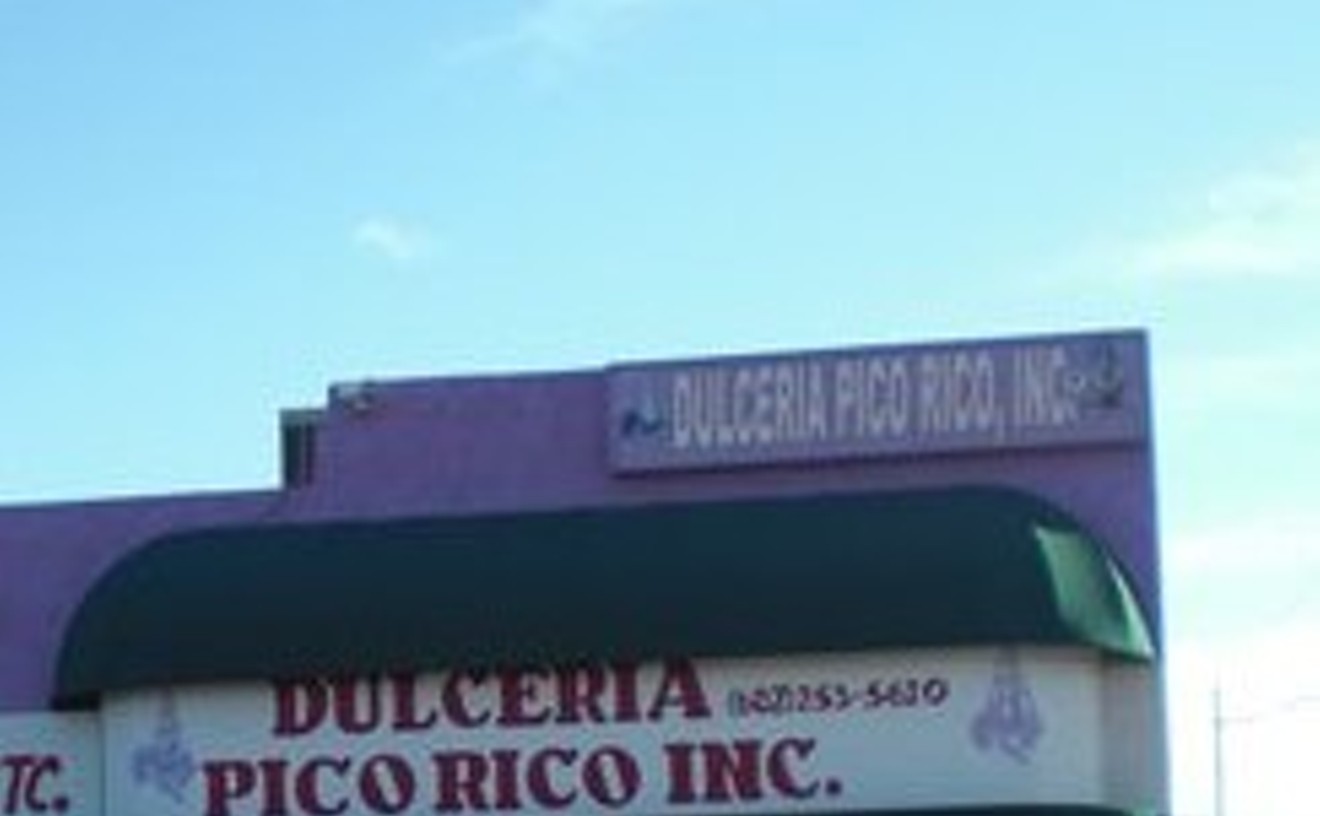This party-supply store is located on the same block as some of our other south-of-the-border staples — across the street from Realeza Michoacana, a bakery and paleta (Mexican popsicle) shop; and Tortas El Güero, a torta shop; and next door to Llantera del Norte. But Dulcería Pico Rico can easily stand alone. It's pretty much a one-stop shop if you're throwing a kid's birthday party (they'll even rent you a jumping castle), but the real reason to go here is the candy. The sweet, tummy-ache-inducing candy. The back of the store is almost entirely devoted to it. Mexican candy has a certain something that makes us want to buy enough to fill several piñatas (also available in abundance here). We think it's probably the packaging — so bright and full of the promise of fun. This place makes it hard to narrow our selection down to a few packages. The candy is divided up into savory (churarzo, in tamarind flavor — a buck and some change will get you 20 pieces), sour, hot (and they carry about a million varieties of the Mexican staple pico), and sweet. We're partial to the sweet. De La Rosa's peanut confections melt in our mouths and remind us of childhood trips across the border, back before you needed a thousand kinds of security clearance to come home.
Best Place to Buy Mexican Candy
Dulceria Pico Rico
Best Raspado
Realeza Michoacana
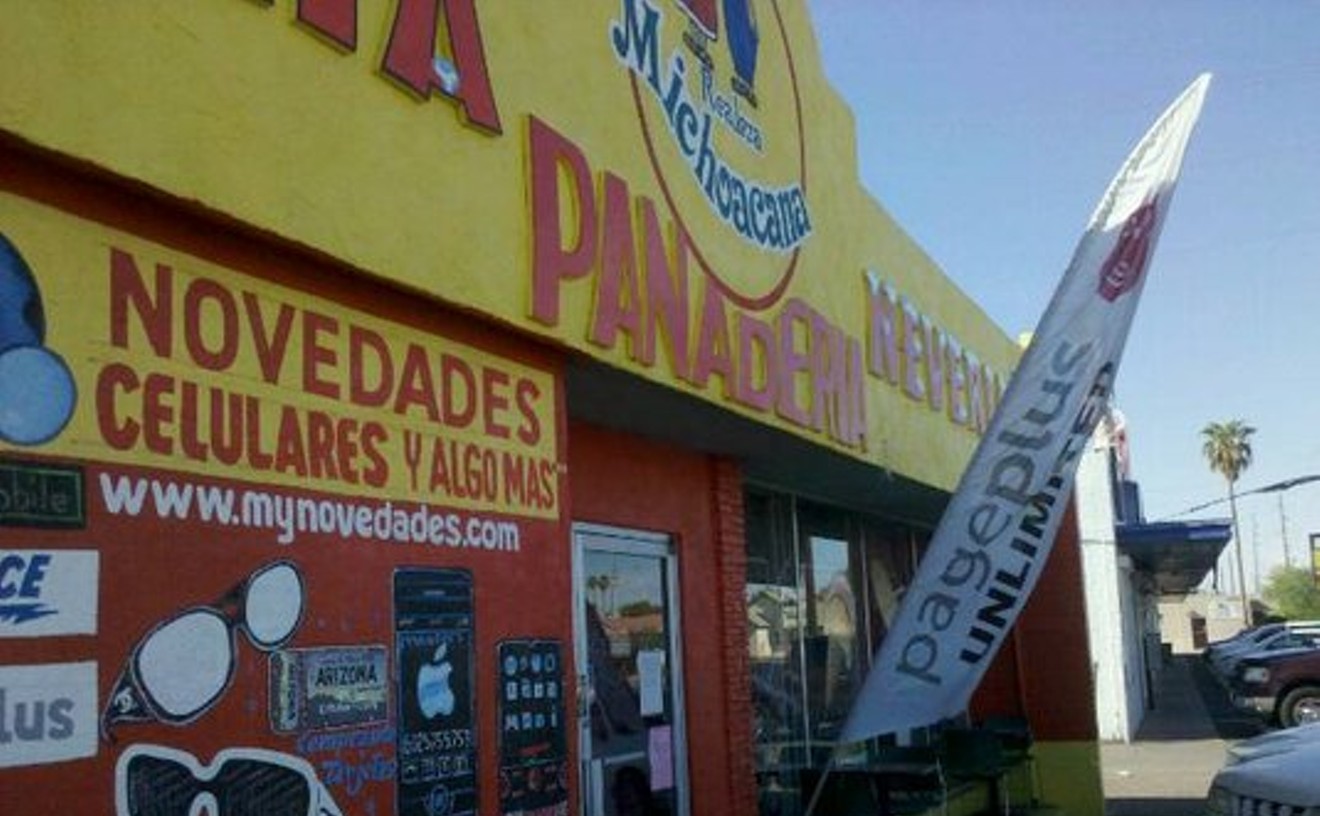
There are lots of reasons to stop by this colorful Mexican sweet shop, from ice cream to fruit cocktails, paletas to pastries (the fruit-filled smiley-face cookies never fail to cheer us up). Even the atmosphere's a hoot, with bright murals of fruit and an eye-popping pink-and-yellow-checkered floor. But usually we just swing by for a refreshing raspado, Mexico's answer to the slushie. Practically overflowing from a tall Styrofoam cup, these babies are chock-full of shaved ice, fruit chunks, and flavored syrups. Order a Diablito, and you'll get a spicy-sweet drink jazzed up with chile powder and saladitos (salted plums) and a chewy candy swizzle stick made with chile and tamarind. Or get one straight up, in one of half a dozen flavors: mango, tamarind, plum, vanilla, strawberry, pineapple, or rompope, a milky-sweet flavor reminiscent of eggnog. In a city where the summer lasts half the year, a regular raspado pit stop makes it much easier to handle the heat.
- 2520 N. 16th St., Phoenix, 85006 Map
- 602-271-4527
- www.facebook.com/realezamichoacana/
Best Place to See Mutant Piñatas
Bragg's Pie Factory
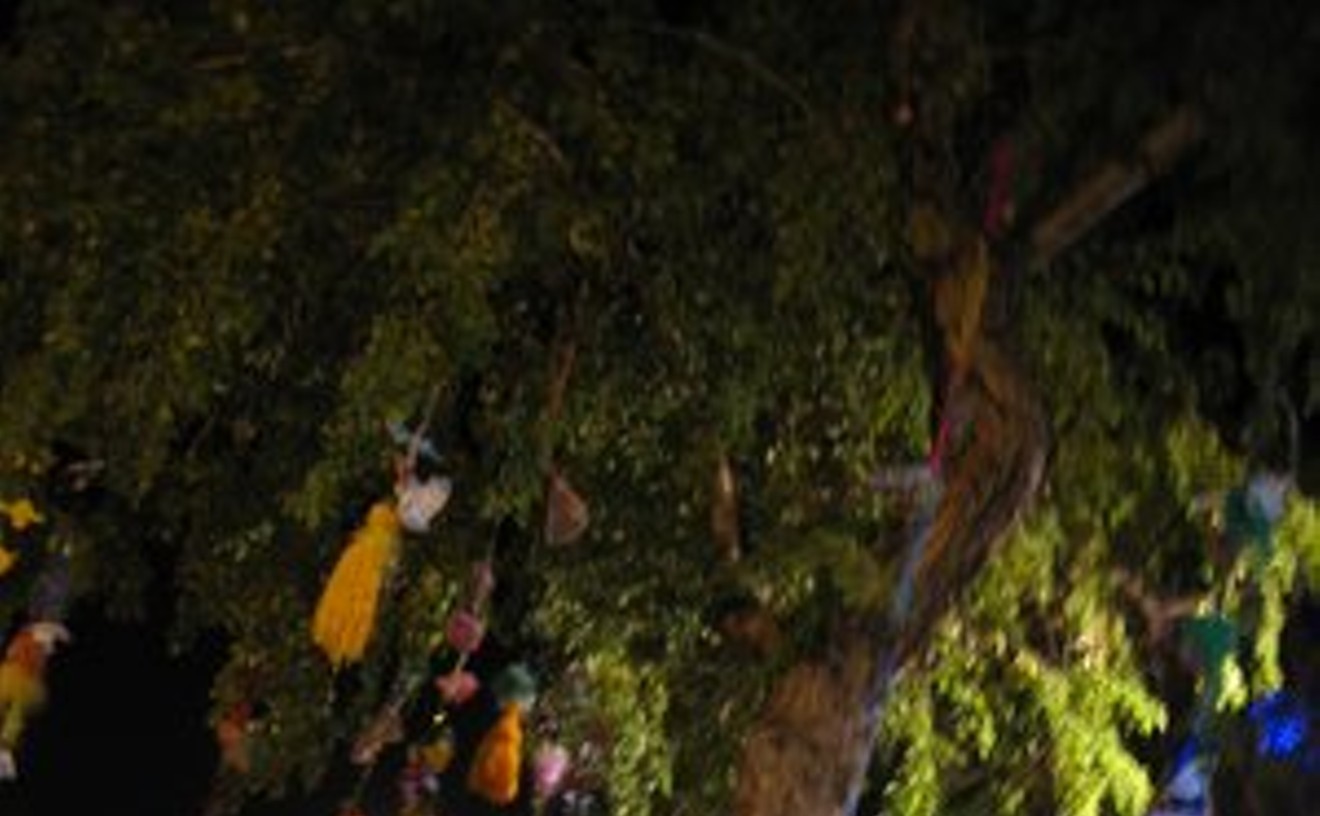
Leave it to longtime downtown arts advocates/developers Beatrice Moore and Tony Zahn to turn a crusty old pie factory into a showcase for genetically modified art. In early April, their latest historic restoration, Bragg's Pie Factory, was filled with description-defying, literally pie-in-the-sky piñatas dangling from the rafters of what was once a state-of-the-art pie-production plant built in 1947 in classic Machine Age "streamline Moderne" style.
Rest assured that the Pie Factory's piñatas are about as far as you can get from those traditional rainbow-decorated donkeys or ones patently inspired by Spider-Man, Hello Kitty and Tickle Me Elmo. Look for next year's call for entries, which is open to all ages and artistic bents. (The "bear" we scored was made by a teenager with autism.) Our other favorites from last year's bizarre-but-beautiful mixed-media offerings include a ginormous spiked blowfish made of scalloped felt and a maniacally grinning and drooling crocodile creature. At least we think it was a crocodile — it's hard to tell with the genetically modified.
- 1301 Grand Ave., Phoenix, 85007 Map
- 602-391-4016
- www.facebook.com/BraggsPieFactory
Best Over-the-Top Swap Meet
El Gran Mercado
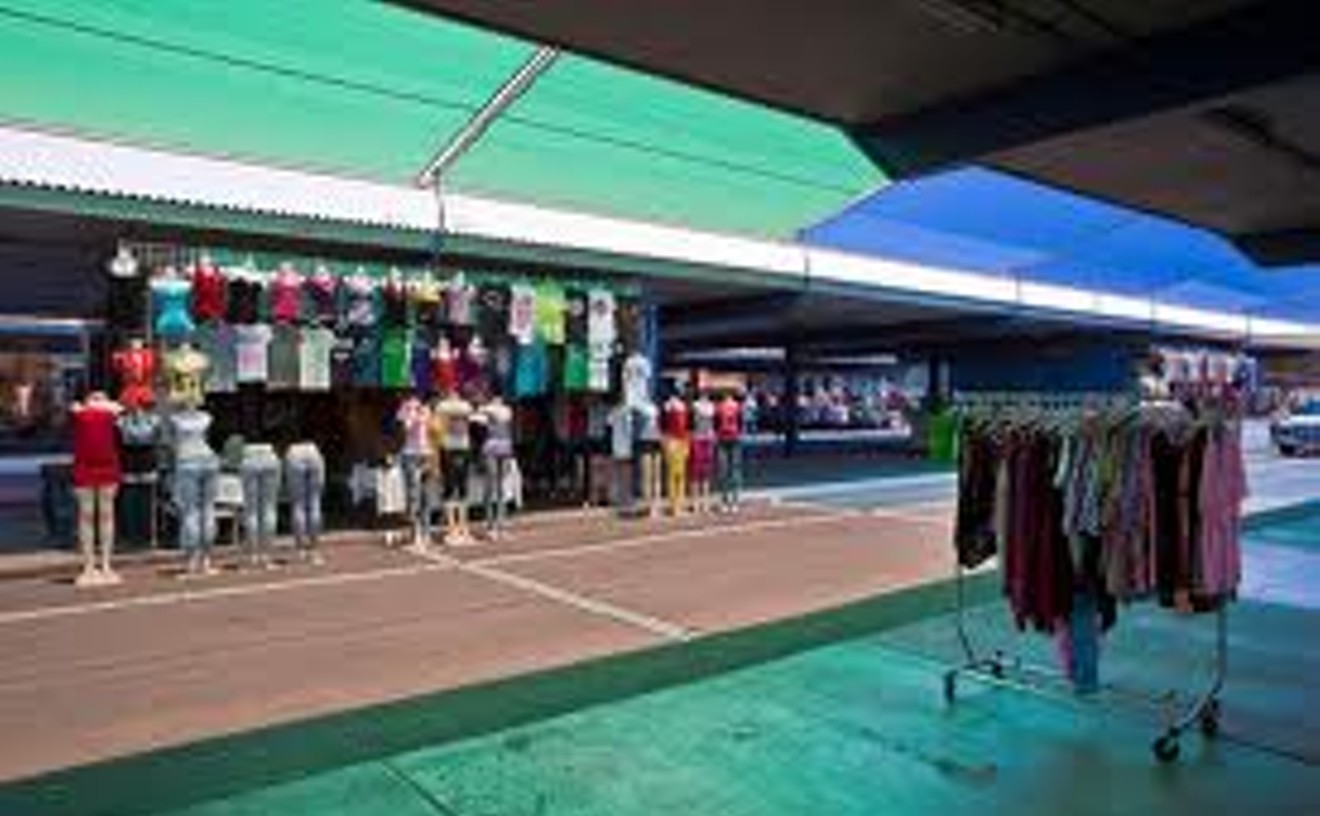
Past the handmade wooden sign marking the entrada, you'll find an outdoor market lined with booths of colorful Mexican pottery, religious statuary, clothing, and Spanish-language cassette tapes. Locals dance to Mexican pop music, sipping cerveza and chowing down on roasted corn with goat cheese. Sounds like a wonderful vacation find, but this isn't Guadalajara — it's SoPo. El Gran Mercado at 35th and Buckeye is the closest thing to a Mexican carnival you'll find north of the border. Think of it as the granddaddy of weekend swap meets. We're talking 300-plus vendors including used car dealers, grocers, and an outdoor barber. You'll have to speak español — at least un poco — to haggle with the merchants; but if you're willing to pay sticker price, you'll do fine without.
- 1820 S. 35th Ave., Phoenix, 85009 Map
- 602-352-1228
Best Amigos
Friends of Mexican Art
So, perhaps the closest to Mexico many members of Friends of Mexican Art (FOMA) have been is Nogales. That doesn't stop this dedicated group of Mexican art-philes, founded more than 45 years ago in Phoenix, from generously donating their time, effort, and funds to promote all aspects of Mexican culture throughout Arizona.
FOMA is the forward-looking organization that had the vision years ago to give the Phoenix Art Museum, among other important artworks, its now-famous Rufino Tamayo painting Dos figuras en rojo (Two Figures in Red) (1973), as well as significant contemporary Mexican fine and folk art to other Arizona cultural institutions, including ASU Art Museum and Tucson Museum of Art. It has sponsored numerous exhibitions of Mexican art and brought working folk artisans stateside. FOMA raised funds for the moving and restoration of Diego Rivera's famous Del Prado Hotel mural painting after Mexico City's 1985 earthquake. It's also contributed to the restoration of frescos in the church of Atotonilco, the very spot where Father Hidalgo first raised the banner of Guadalupe to kick off the movement for Mexican independence from Spain. Known as the Sistine Chapel of the Americas, this church made the World Monuments Fund's list of the 100 most endangered world monuments.
Recently, FOMA ponied up bucks to help underwrite a historically critical issue on Mexican tourist pottery by Mexico's most prestigious arts publication, Artes de Mexico. The group's primary source of fundraising is its annual springtime Hacienda Home Tour and Mercado, which showcases elegant homes with mostly Mexican art collections and sells folk art that's cherry-picked for its quality. For gringos, this group's got it going on when it comes to putting its money where its heart is.
Best Mirror on the City
"The Mexican American Mirror/El Espejo México Americano: Reflections of Our City's Heritage"
Trinidad Escalante crossed the border into Arizona about a century and a half back. While we could all sit around and argue about whether or not she did it legally, one fact can't be debated. Trinidad is yo' mama, Phoenix. In 1864, she married a man named Jack, and the two rounded up a bunch of their day-labor Mexican friends to work on a fancy canal system roughly 90 miles north of Tucson. That irrigation system became the foundation for a thriving southwestern community that we all know and love. For their act of desert insanity, we've christened Trinidad Escalante Swilling and Jack Swilling (indeed, the city's first mayor) the mother and father of Phoenix.
Trinidad is just one of the brown babes you'll meet at the Phoenix Museum of History's latest exhibit that showcases the stories of local Latinos from the Wild West days of the 1860s through the politically charged 1960s. It turns out that when Phoenix was founded in 1870, the population was over 50 percent Hispanic. Take a closer look at your Latin roots by peering into "The Mexican American Mirror" exhibit through October 2009.
Best Glitter
Kathy Cano-Murillo, the Crafty Chica
For years, she's slaved with the hot glue gun, hoping to make it big. And she has — syndicated newspaper column, books, public appearances, sales of original folk art, workshops, even a show this fall at the Heard Museum.
But all that pales next to the shiny stuff. This year, Kathy Cano-Murillo hit the crafter's jackpot with her own product line, on sale at Michael's. Holy Chihuahua! In fact, you can have one of those, in the form of a Crafty Chica iron-on, as well as other iron-ons, paints, and even DIY shrine kits. But our favorite CC creation has got to be Cano-Murillo's staple ingredient — glitter, which comes in 10 custom colors including Frida's Fuchsia, Rockabilly Ruby, and Popstar Purple.
Star, indeed! The Valley's own Crafty Chica is making the world sparkle, one craft project at a time.
Best Mexican Folk Art Mural
MJ Mini Mart
It was an agonizingly tough decision, given the competition, but we finally decided we're partial to a true Mexican folk art mural gracing the west side of MJ Mini Mart, a combo carnicería/casa de cámbio/restaurant in Sunnyslope. A visual paean to the platonic ideal of cows, pigs, and Mexican cerveza, the exuberant painting features two bigger-than-life-size horned cows — one of them looks as though it just had a root canal — that sort of levitate against green mountain vistas. Add a floating Tecate bottle, a flowering maguey, a bright yellow rope that spells out "carniceriá," and a decapitated pig's head staring ominously into the distance, and you get folk art at its finest — with the profound subtext that there are greener pastures waiting for us all.
- 1201 W. Hatcher Rd., Phoenix, 85021 Map
- 602-861-2493
Best Place to See Day of the Dead Ofrendas
Arizona Historical Society Museum at Papago Park, Tempe
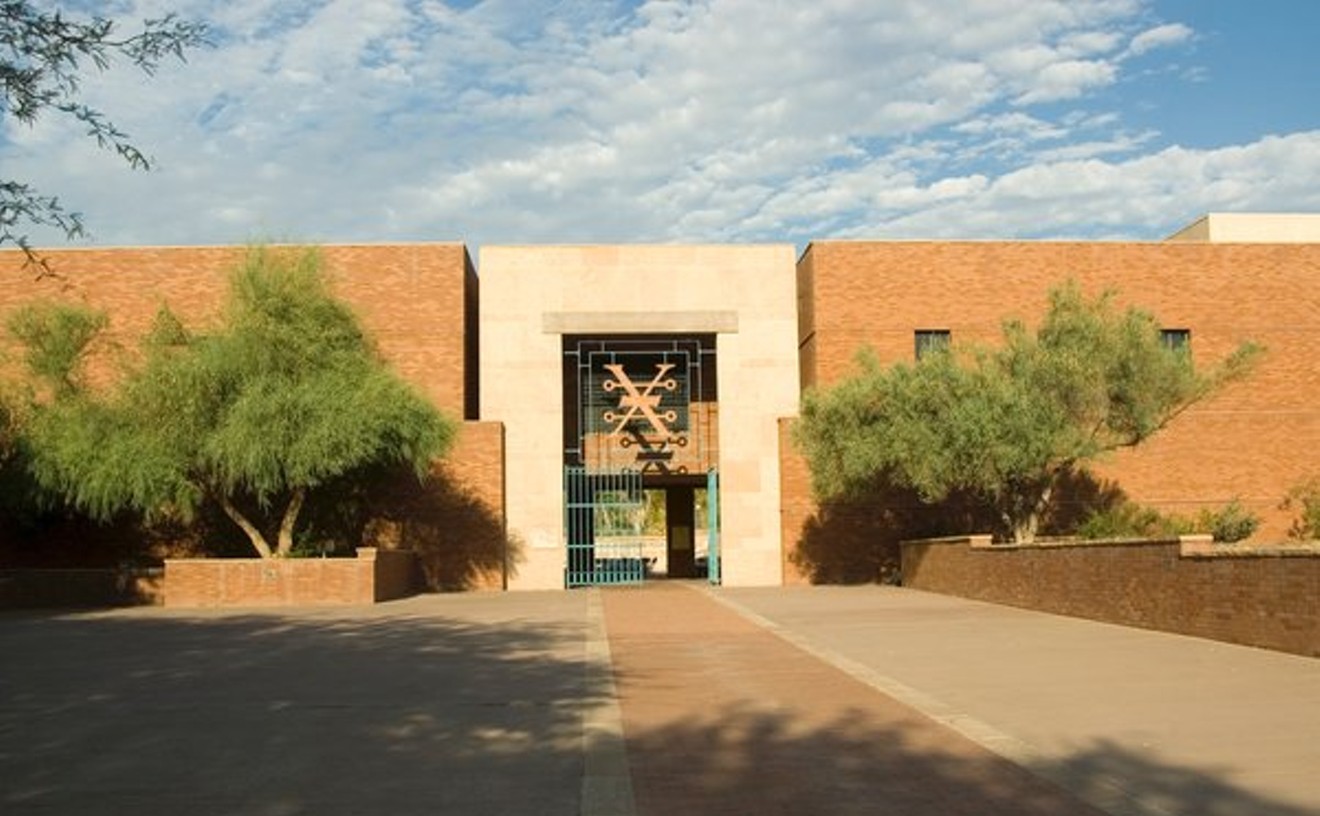
Arizona is now embracing its Mexican roots big-time, especially around the time of Día de los Muertos, an ancient Mexican tradition that marries pre-Columbian social ritual to 16th-century Spanish Catholicism. The raucous result is a less-than-somber celebration devoted to honoring the dearly departed by annual graveyard cleaning and partying all night next to one's buried kin.
Probably the best part of this four-day holiday is the elaborately decorated ofrendas, or home offering tables, decked out with family photos, flowers, sugar skulls and candles. They're created to present tidbits of the departed's favorite food, drink, and even smokes, to lure lost souls back to Earth for the evening.
Last year, the Calaca Cultural Center collaborated with the Arizona Historical Society Museum on its fourth annual Día de los Muertos Altar and Art Exhibition, which showcases altars built by artists and community members (check Calaca's Web site for details about this year's "Call for Altars"). The museum displayed the ofrendas and invited the public to add to a large, four-sided altar. If you're into spectacle and religious rites, or are just enamored of all things Mexican, don't miss this sensory-overloading celebration at AHS Museum, which also includes an opening complete with food, entertainment, and purveyors of Mexican folk art.
- 1300 N. College Ave., Tempe, 85281 Map
- 480-929-9499
- www.arizonahistoricalsociety.org
Best Place to Snag Day of the Dead Stuff
Mesa Arts Center

Give the dead their due and buy cool stuff, too, at the Día de los Muertos Celebration held at Mesa Arts Center in downtown Mesa. This annual Day of the Dead extravaganza, usually mounted as close to November 1 and 2 as possible (the dates conveniently coincide with All Souls' and All Saints' days on the Catholic liturgical calendar), boasts a two-day Mexican folk art mercado, a community-built altar (called an ofrenda) and altar contest, family-oriented artist workshops and a special procession with guest appearances by crazed skeletons decked out like José Guadalupe Posada characters.
Free to the public, this fiesta's the perfect place to score fabulous folk art from all parts of Mexico, with an emphasis on all things bony and skeletal. Selected sellers from various parts of town converge to offer convenient, one-stop shopping for choice Mexican handicrafts, including ceramics, papier-mâché and carved wood from Jalisco, Michoacán, Guerrero, Oaxaca, and other Mexican folk-art-producing areas, not to mention Mexican-inspired items made right here in Arizona. And don't forget to check out the Day of the Dead items stocked by The Store at Mesa Arts Center when you're not shopping and stuffing your face with homemade tacos. Check the center's Web site for exact days and event times for this year's festivities.
- 1 E. Main St., Mesa, 85211 Map
- 480-644-6500
- www.mesaartscenter.com


